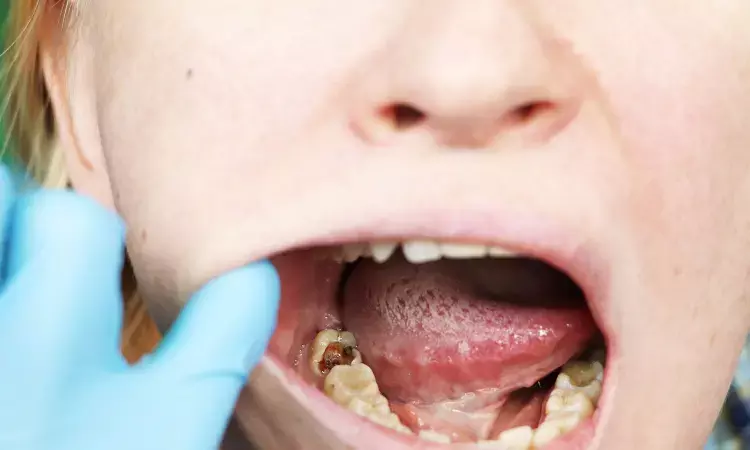- Home
- Medical news & Guidelines
- Anesthesiology
- Cardiology and CTVS
- Critical Care
- Dentistry
- Dermatology
- Diabetes and Endocrinology
- ENT
- Gastroenterology
- Medicine
- Nephrology
- Neurology
- Obstretics-Gynaecology
- Oncology
- Ophthalmology
- Orthopaedics
- Pediatrics-Neonatology
- Psychiatry
- Pulmonology
- Radiology
- Surgery
- Urology
- Laboratory Medicine
- Diet
- Nursing
- Paramedical
- Physiotherapy
- Health news
- Fact Check
- Bone Health Fact Check
- Brain Health Fact Check
- Cancer Related Fact Check
- Child Care Fact Check
- Dental and oral health fact check
- Diabetes and metabolic health fact check
- Diet and Nutrition Fact Check
- Eye and ENT Care Fact Check
- Fitness fact check
- Gut health fact check
- Heart health fact check
- Kidney health fact check
- Medical education fact check
- Men's health fact check
- Respiratory fact check
- Skin and hair care fact check
- Vaccine and Immunization fact check
- Women's health fact check
- AYUSH
- State News
- Andaman and Nicobar Islands
- Andhra Pradesh
- Arunachal Pradesh
- Assam
- Bihar
- Chandigarh
- Chattisgarh
- Dadra and Nagar Haveli
- Daman and Diu
- Delhi
- Goa
- Gujarat
- Haryana
- Himachal Pradesh
- Jammu & Kashmir
- Jharkhand
- Karnataka
- Kerala
- Ladakh
- Lakshadweep
- Madhya Pradesh
- Maharashtra
- Manipur
- Meghalaya
- Mizoram
- Nagaland
- Odisha
- Puducherry
- Punjab
- Rajasthan
- Sikkim
- Tamil Nadu
- Telangana
- Tripura
- Uttar Pradesh
- Uttrakhand
- West Bengal
- Medical Education
- Industry
Most Indirect Pulp Capping Materials Safe for Deep Cavities Without Compromising Dentin Seal: Study

Most indirect pulp capping Materials, except for Kerr Life, do not compromise the peripheral seal to dentin in very deep cavity areas. Further, hydraulic cements can be used without negatively affecting the dentin seal.
The aim of this in-vitro study was to evaluate the effect of different indirect pulp capping (IPC) materials on bond strength to surrounding dentin. Fifty-six human third molars were used in this study.
Occlusal dentin of 42 teeth was exposed. Dentin surfaces (n = 6) were left uncovered (control) or received a 1 × 1 mm central IPC (KL: Kerr life, DY: Dycal, TC: Theracal LC, CL: Calcimol LC, BD: Biodentine, and PR: ProRoot MTA) and were then bonded with Scotchbond Universal adhesive and restored with a composite resin build-up (Filtek™ Z250). After 24 h of water storage, the specimens were cut into sticks, which were marked red (1 mm distance from IPC spot), green (2 mm distance), and blue (3 mm distance). Consequently, µ-TBS tests were performed and analyzed using one-way ANOVA (P 0.05) for normal distributions and Mann–Whitney U-test (P 0.05) for non-normal distributions.
Pretesting failures were recorded as 0 MPa. Fracture modes were analyzed under a fluorescence microscope, and interfaces and surfaces of 14 additional specimens were visualized under a scanning electron microscope (SEM). Results: A significant reduction in peripheral seal was only observed for KL (Mann–Whitney U-test, P 0.05).
All groups showed increasing bond strengths from the IPC area to the periphery, indicating a certain contamination potential of IPC materials. IPC materials being applied in very deep cavity areas except Kerr Life do not harm peripheral seal to dentin. Especially, hydraulic cements can be used without a negative effect on the peripheral dentin seal.
Reference:
Frankenberger, R.; Koch, A.; Plohmann, L.; Beck-Broichsitter, B.; Becker, S. The Outcome of Old-School Indirect Pulp Capping over 40 Years: A Practice-Based Retrospective Evaluation. Dent. J. 2025, 13, 182. https://doi.org/10.3390/dj13050182
Dr. Shravani Dali has completed her BDS from Pravara institute of medical sciences, loni. Following which she extensively worked in the healthcare sector for 2+ years. She has been actively involved in writing blogs in field of health and wellness. Currently she is pursuing her Masters of public health-health administration from Tata institute of social sciences. She can be contacted at editorial@medicaldialogues.in.
Dr Kamal Kant Kohli-MBBS, DTCD- a chest specialist with more than 30 years of practice and a flair for writing clinical articles, Dr Kamal Kant Kohli joined Medical Dialogues as a Chief Editor of Medical News. Besides writing articles, as an editor, he proofreads and verifies all the medical content published on Medical Dialogues including those coming from journals, studies,medical conferences,guidelines etc. Email: drkohli@medicaldialogues.in. Contact no. 011-43720751


